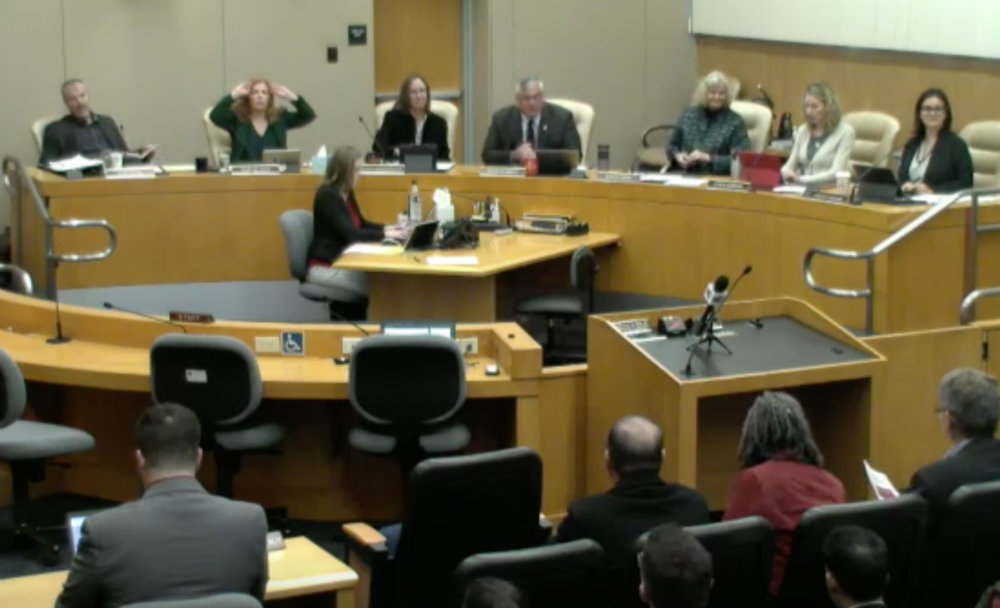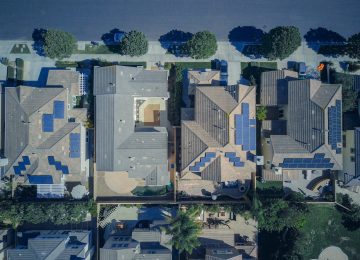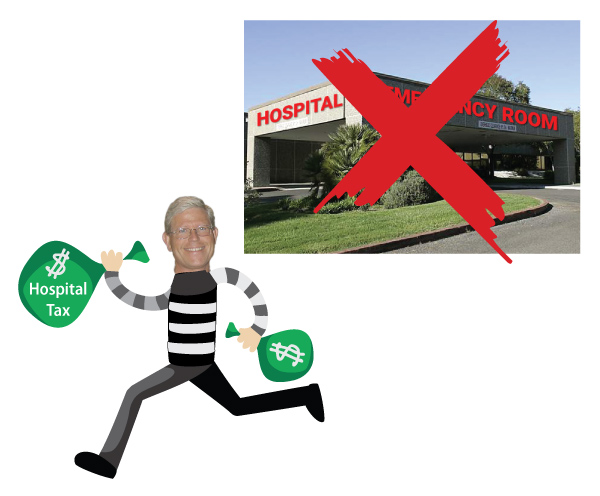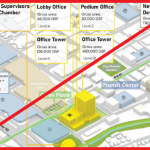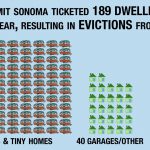The Board of Supervisors is set to vote Tuesday on what would be the largest construction project in Sonoma County history. The $1.65 billion dollar plan to move the county administration campus to downtown Santa Rosa has barreled ahead despite serious concerns about parking, traffic, and impacts to downtown businesses during construction. Importantly, the Board has not had a serious discussion of whether they can even afford a mortgage payment of up to $55 million per year, or what services will need to be cut to do so.
While the current county campus has 82 acres, the Sears site has less than 8. Supporters say the Sears site would be a benefit to the environment and further the county’s climate goals, but without any environmental studies of the Sears site or alternatives, this borders on greenwashing. At a time when the county is still recovering from the pandemic, struggling with a homelessness and housing crisis, and as citizens face rising inequality, now is not the time to saddle the county with 30 years of debt, especially when there are other, arguably better options.
The Board of Supervisors can choose to address the aging buildings making up the administration campus in multiple ways. What they should not do is put the desire to have a prestigious new downtown building, and the hundreds of millions of contract dollars that flow from it, above providing services to the people of Sonoma County. By all accounts the Sears project would do just that.
Prior to the February 8th board meeting, it looked like the Supervisors were set to approve the $21 million purchase of the Sears site. The Press Democrat has reported on the move as a done deal instead of a proposal under consideration. The day before the February 8th vote they wrote that the board was “poised to sign off on buying the former Sears site.”
Remarkably, this vote was to happen before a plan had been developed to explain how the $1.65 billion project would be paid for.
“Today it’s a $21 million dollar decision, but it’s really not that, it’s a $1.2 to $1.65 billion dollar decision that we’re making if we follow through on this…. The big question for this Board is what services are we not going to add dollars to over the course of that time [the thirty year mortgage], that we have in the past.” Supervisor Rabbitt said.
Rabbit observed that while the county needs new buildings, it may be more feasible to stay at the current county site and improve or build new buildings as funding becomes available. In speaking out against the premature purchase, Rabbit knew that the board needed a four fifths majority to approve the purchase, but that further decisions would only require three of the five supervisors to vote yes.
With Supervisors Gore, Coursey, and Gorin firmly behind the Sears site, this represented the last real hurdle for the project. In a dramatic, unexpected show of independence and long range thinking, Supervisors Rabbitt and Hopkins broke with the majority and said they would not vote yes for the project in its current form. Because they couldn’t reach the needed four votes, Chair Gore tabled the vote until March 1st.
Supervisor Rabbit, who was the only board member initially opposed to the project, stated “The truth of the matter is that if we build on this site it’s at least $150 million cheaper, that same project… and that’s probably being very conservative in terms of the savings.”
Supervisor Hopkins also voted against the project. Instead of the robust satellite services she had requested, staff presented a massive, $1.65 billion dollar central campus with only a mobile van for satellite services.
“I supported downtown plus satellite/neighborhood services, and a smaller footprint building to maximize telework. What came back was a massive cost for the downtown location with minimal satellite services and no commitment to telework.” Hopkins said in a facebook comment after the meeting.
Compared to the price tag of the central campus, only $1 million per year was dedicated to satellite services. “Is there flexibility with the $1 million dollars, which I find to be totally inadequate for satellite services?” she asked county staff.
Rabbitt repeated his concerns that the county could not afford the 18-story Sears campus, and that regardless, he couldn’t vote for it without seeing how the county would finance the project.
Over the Summer the board voted 4-1 to submit a letter of intent to purchase the Sears site and directed staff to begin the process of studying financing and addressing other aspects of the move. At that time Supervisor Rabbitt was the lone “no” vote. Supervisor Hopkins voted “yes” with the understanding that the county would open service locations in west and north county, and in the Sonoma Valley, with a leaner central campus. The other Supervisors supported the project.
Why the county wants to move the campus
The current county administration campus was built in the 1950’s and needs significant improvement to meet current standards. The buildings are old, inefficient, and have accrued deferred maintenance costs totaling $367 million dollars, with those costs projected to continue increasing every year. Because county staffing needs have increased significantly over the last 60 years, the county has leased other buildings in a piecemeal fashion. Studies commissioned by the county have shown that it will be less expensive to replace the existing buildings than it would be to fully bring them up to modern standards.
There are good arguments as to why the county needs new buildings, and there is no question that significant maintenance at the current campus has been deferred. However, there seems to be little reason besides downtown prestige to choose the Sears site.
The current county campus is 82 acres. It has no parking garage and does not have a shortage of parking. The Sears site is less than 8 acres and faces a serious shortage of parking. The Sears site is marginally more convenient for some Santa Rosa residents, but is less convenient for residents of west and north Sonoma County, while residents in the south are already served by a satellite service center in Petaluma.
When the Board of Supervisors asked county staff to prepare possible plans for the administrative center, they returned on July 27, 2021 with four options. One site was on Airport Blvd, one was at the downtown Santa Rosa library location, one was the Sears site, and one option was to stay at the current site.
Out of these four options, the Sears location was the most expensive. While staff said it was a better option than the library location, they recommended that the county campus stay at its current location.
Looking at affordability, service, design, and other considerations, county staff gave each site a score out of one hundred. Staying and building at the current location received a score of ninety, while the Sears location received a score of seventy-five. Supervisors certainly shouldn’t blindly follow staff recommendations, but in this case it’s worth noting that even county planners thought that staying at the current location was a better option.
The total cost of the project is unknown but estimates range from $35 to $55 million per year for 30 years. This is a huge cost and would make it the most expensive building project in Sonoma County history.
Greenwash or environmental benefit?
One of the persistent narratives being told about the county’s plan to move to the Sears site is that it will be good for the environment. Members of the public, the Press Democrat editorial board, and supervisors have all claimed that the project will be a benefit to the environment. “Think about the future. Walk our talk. The downtown county center is walking our talk. As far as, first of all, excellence in government, city center growth, and climate action.” Supervisor Coursey commented during the February 8th meeting.
The reality is that no environmental review or study has been conducted that could verify this claim. We reached out to Supervisor Coursey to give him an opportunity to explain his position, but he has not responded. County public affairs confirmed that no environmental report was planned until the one mandated by the California Environmental Quality Act, which would take place after the project is approved.
It is true that the current county campus does not meet energy efficiency standards. What is not clear is if moving to the Sears site would have any environmental benefit over other options, like building at the current location. In fact, common sense would indicate that the Sears site is likely to be the least environmentally friendly option.
Embodied carbon, the upfront carbon costs of construction materials and processes, account for more than 10% of global carbon output. There is consensus among engineers that renovating an existing structure typically has a much lower carbon footprint than building a new one. A building’s foundation and structure are the most carbon intensive parts of a building and reusing them by building on existing foundations, or making use of existing structural components, can drastically lower embodied carbon costs.
In addition to the embodied carbon costs of the new construction, more cars idling downtown increases both VOC air pollution and carbon emissions. Supporters of the move have suggested that employees will take public transportation if the campus is moved downtown, but there is no reason to think that they would be more likely to take the bus downtown if they aren’t taking it already.
There may be good arguments to move the county campus downtown, but environmental benefits are not one of them. Without even a tentative environmental study, anyone suggesting that the Sears site furthers climate goals is engaging in greenwashing a $1.65 billion project.
Parking, Traffic, and Public Transportation
The most obvious problems with moving the county campus to the downtown Sears site are the lack of parking and worsening traffic. The downtown 101 exit and the surrounding area are some of the most congested intersections in the county. Adding another fifteen hundred to more than twenty five hundred additional people and vehicles to the area on a daily basis risks making downtown Santa Rosa undrivable.
At the current county campus parking is not a problem, but in downtown Santa Rosa parking is already at a premium. The county has put forward various alternatives to come up with enough parking spaces for employees, fleet vehicles, and visitors. In all of these alternatives the Sears site faces a serious shortage of parking spaces.
If the county maintains its current staffing and does not increase the number of employees working remotely, then as many as 2,408 parking spaces could be needed. County staff have been able to identify a maximum potential total of 1,688 parking spaces. This includes 638 spaces at the Sears site, 550 spaces rented from the Santa Rosa Plaza Mall, and 500 spaces rented from the City of Santa Rosa.
If 30% of the workforce works remotely, then the parking deficit could potentially be reduced to 500 spaces. Most recently county staff put forth an option, that with 50% of employees working from home, would reduce the parking deficit down to less than 200 spaces. There has so far been no discussion on whether that level of remote work is even feasible long term.
This also begs the question of whether, if the county is comfortable with that level of remote work, why they have not considered it to reduce staffing pressure at the current campus or to consolidate leased facilities. Regardless of what the Board decides, the county will still need to negotiate a labor agreement with employee’s unions. Current labor contracts do not allow, outside of covid policies, for that level of remote staffing.
“I’m also concerned as a county organization that we haven’t committed to a telework policy which would ultimately minimize the footprint of the building and also reduce our costs. We need to have that conversation around telework. We need to have that conversation about satellite sites, before we move forward with this huge, huge investment.” Hopkins said during the February 8th board meeting.
Public transportation access has been another selling point put forth by the county as to why the Sears site is the best alternative. Supporters have pointed to Sears’ proximity to the Smart Train and the Sonoma County Transit Station as a benefit. Locating services near public transit is a laudable goal, but in this case, in Sonoma County, moving the campus less than three miles within Santa Rosa will make little difference for residents or county employees. The Smart Train only serves Petaluma and Rohnert Park, and Petaluma already has a satellite service center, while bus routes from west and north county often take the same or less time to reach the current county campus than the downtown transfer center.
Hopkins continued, “I’d like to be able to vote yes on a plan with clearly identified funding sources. A plan that includes supporting rural residents for whom accessing services in downtown Santa Rosa actually becomes more challenging. Ultimately this is about resources, resources for the foreseeable future. And I feel like we’re being asked to put those resources for the foreseeable future into downtown redevelopment.”
A Better Solution: Neighborhood Service Centers and a Decentralized Green Future
While many have suggested that moving the county campus to Sears would be a forward thinking, green project, one that will expand and improve county services, it is in some ways more anachronistic. Looking to the future, rather than increasing centralization, a strong case can be made that decentralization and distributed services are both better for the environment and the public. Distributing government services reduces carbon and improves access by bringing them closer to both end users and employees.
The satellite service model paired with a smaller consolidated central campus at the current location, made possible by having 30%-50% of staff working remotely, is an option that meets all of the county’s needs while avoiding the serious problems with the Sears site. This is similar to what Supervisor Hopkins has suggested, except that instead of moving downtown, the campus would stay at its current location.
In a facebook post following the February 8th vote, Lynda Hopkins asked her followers what they thought of the project. Out of the commenters that took a stance on the issue eighty-four were against the Sears site, while only five supported moving the campus to Sears. People were generally opposed to the project over the clear and obvious problems with the location. Some expressed disbelief that such an expensive project would even be considered.
Among the commenters, “This plan feels like it should be satire, only it’s sadly reality,” Eliza Hemenway wrote. “People work so hard for tax dollars; need more confidence in how they are being spent.”
Responding on Facebook with her personal opinion, Gillian Hayes, who as Interim Assistant City Manager of Vallejo has extensive experience with governance, wrote, “Irresponsible spending in a time where hybrid work schedules should be the norm and saving money should be the priority. Just say no!”
Betsy Aparicio wrote “We should be focusing on teleworking for employees to promote and reduce congestion on our roads. We should also look at expanding to locations in our communities that we serve. I can’t imagine the burden of living in Cloverdale, or Healdsburg is to be able to see someone in an office.”
The Simple Solution is to Repair the Current Location & Decentralize Services
Keeping the administration center where it is would be far less expensive, would likely be better for the environment, and with reduced staffing from the satellite service centers and increased remote work, would still allow the county to consolidate it’s leased properties onto one campus. Satellite service centers in west county, north county, and the Sonoma Valley would vastly improve services for individuals in those regions and reduce the burden of having to waste gas driving into Santa Rosa to interact with county government.
With this type of plan the project could potentially also be done in phases, as the county is able to secure funding, addressing Supervisor Rabbitt’s concerns. The county would still get its new facilities, services would be improved, and the county would meet its climate commitments. While this would still be costly, it would be nowhere near as costly as the plan to move Sears downtown. It would not risk crippling county services for the next thirty years.
“I think we’re going to have to do things the old fashioned way. When you don’t have the money to buy that mansion on the hill, you take the money you do have and the property you have and build one building at a time, you do it in a way you can afford, and you live within your means, and you continue to do that over the course of time,” Supervisor Rabbitt said.
What you can do
The Board will be discussing this issue on March 1st and there will be an opportunity for public comments. You can join that meeting here and find the agenda here. The project will be discussed both in the morning session as item #35 and in the afternoon session as items #43 and #44.
If you can’t make the meeting, you can call the supervisors at (707)565-2241 or email the them your comments at the following addresses:
Susan.Gorin@sonoma-county.org, David.Rabbitt@sonoma-county.org, Chris.Coursey@sonoma-county.org, district4@sonoma-county.org, district5@sonoma-county.org

